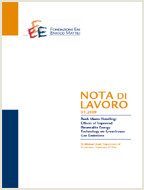The “Doomsday” Effect in Climate Policies. Why is the Present Decade so Crucial to Tackling the Climate Challenge?

05.09.2012
Baptiste Perrissin Fabert, Etienne Espagne, Antonin Pottier, Patrice Dumas
C61, Q54, Q58
Integrated Assessment Model, Non Linear Effect, Doomsday Effect, 2°C Target
Climate Change and Sustainable Development
Carlo Carraro
Despite growing scientific evidence that passing a 2°C temperature increase may trigger tipping points in climate dynamics, most Integrated Assessment Models (IAM) based on Cost Benefit Analysis (CBA) with smooth quadratic damage functions are unable to account for the possibility of strong increase in climate damage. Our IAM RESPONSE makes it possible to bridge this gap by integrating a threshold effect damage function which sets a threshold of temperature increase from which climate damages increase significantly. To fit with on-going climate negotiations, this threshold is set at 2°C. Regardless of the bleak prospect of passing the threshold, it turns out that among a broad set of scenarios accounting for the diversity of worldviews in the climate debate, overshooting the 2°C target and then facing the resulting damage may become an optimal strategy for many economic agents who are struck by what we call a “doomsday effect”. We show that this effect happens for any level of jump in damage and dramatically increases if the beginning of mitigation efforts is postponed till the decade 2010-2020 on. In light of these results, we believe that any further delay in reaching a clear international agreement will close the window of opportunity for meeting the 2°C target with a reasonable chance of diplomatic success.
